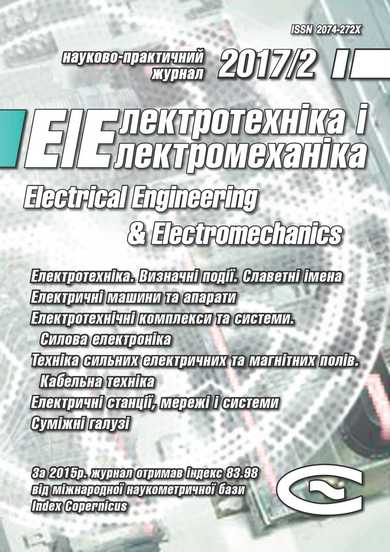IMPROVING CALCULATION ACCURACY OF CURRENTS IN CABLE SHIELDS AT DOUBLE-SIDED GROUNDING OF THREE-PHASE CABLE LINE
DOI:
https://doi.org/10.20998/2074-272X.2017.2.06Keywords:
cable line, shield of a cable, shield current, double-sided groundingAbstract
This paper deals with the calculation of currents in shields of single-core cables at double-sided grounding of three-phase cable lines. We consider flat and trefoil cable lines and receive the analytical expressions for RMS currents in the shields of cables. These expressions allow reducing the shield current calculation error to value of 5 %. We analyze the known approximate expressions for RMS currents in the shields of cables and represent dependencies of corresponding calculation errors on cable line dimensionless parameters. These dimensionless parameters are determined by the distance between the axes of the cables, the radius and the resistance of shields.References
1. Bystrov A.V. Razrabotka metodiki vybora energoeffektivnoi sistemy zazemleniia ekranov odnozhil'nykh silovykh kabelei s izoliatsiei iz sshitogo polietilena na napriazhenie 6-500 kV. Autoref. diss. kand. techn. nauk [The development of selection methodology of energy efficient grounding systems of 6-500 kV XLPE insulated single-core power cable shields. Abstracts cand. tech. sci. diss.]. Moscow, 2014. 20 p. (Rus).
2. Grinchenko V.S. Increase of screening efficiency of technogenic magnetic field of underground high-voltage power cables. Visnik Nacional’noi’ akademii’ nauk Ukrai’ni – Herald of the National Academy of Sciences of Ukraine, 2014, no.8, pp. 71-76. (Ukr).
3. Rozov V.Yu., Dobrodeyev P.N., Erisov A.V., Tkachenko A.O. Increasing the efficiency of contour shielding of the magnetic field of high-voltage cable lines. Tekhnichna Elektrodynamika, 2016, no.4, pp. 5-7. (Rus).
4. Rozov V.Yu., Kvytsynskyi A.A., Dobrodeyev P.N., Grinchenko V.S., Erisov A.V., Tkachenko A.O. Study of the magnetic field of three phase lines of single core power cables with two-end bonding of their shields. Electrical engineering & electromechanics, 2015, no.4, pp. 56-61. (Rus). doi: 10.20998/2074-272X.2015.4.11.
5. Antonets T.Yu., Vepryk Yu.M., Shchebeniuk L.A. Heat tests of power cables with XLPE insulation at direct voltages up to 110 Kv. Electrical engineering & electromechanics, 2015, no.6, pp. 43-46. (Ukr). doi: 10.20998/2074-272X.2015.6.07.
6. Shchebeniuk L.A., Antonets T.Yu. Investigation of losses in insulation of high-voltage power cables with XLPE insulation. Electrical engineering & electromechanics, 2016, no.4, pp. 58-62. (Ukr). doi: 10.20998/2074-272X.2016.4.08.
7. Pravila ulashtuvannya electroustanovok [Electrical installation regulations]. Kharkiv, Мinenergovugillya of Ukraine Publ., 2014. 793 p. (Ukr).
8. Larina E.Т. Silovye kabeli i vysokovoltnye kabelnye linii [Power cables and high-voltage cable lines]. Moscow, Energoatomizdat Publ., 1996. 464 p. (Rus).
9. Kalantarov P.L., Tseytlin L.A. Raschet induktivnostey [Inductance calculations]. Leningrad, Energoatomizdat Publ., 1986. 488 p. (Rus).
10. Rozov V.Yu., Tkachenko A.O., Erisov A.V., Grinchenko V.S. Analytical calculation of magnetic field of three-phase cable lines with two-point bonded shields. Tekhnichna Elektrodynamika, 2017, no.2, pp. 13-18. (Rus).
Downloads
Published
How to Cite
Issue
Section
License
Copyright (c) 2017 V. S. Grinchenko, A. O. Tkachenko, N. V. Grinchenko

This work is licensed under a Creative Commons Attribution-NonCommercial 4.0 International License.
Authors who publish with this journal agree to the following terms:
1. Authors retain copyright and grant the journal right of first publication with the work simultaneously licensed under a Creative Commons Attribution License that allows others to share the work with an acknowledgement of the work's authorship and initial publication in this journal.
2. Authors are able to enter into separate, additional contractual arrangements for the non-exclusive distribution of the journal's published version of the work (e.g., post it to an institutional repository or publish it in a book), with an acknowledgement of its initial publication in this journal.
3. Authors are permitted and encouraged to post their work online (e.g., in institutional repositories or on their website) prior to and during the submission process, as it can lead to productive exchanges, as well as earlier and greater citation of published work.





